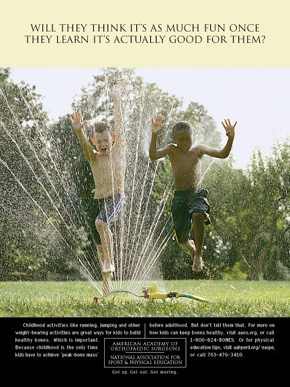Kids Excercise
 Description
Description
Kids' fitness levels are dragging. Only one in four American schoolchildren gets an adequate amount of physical activity each day. The number of overweight children is rising rapidly. Almost 13 percent of 6 to11 year olds are obese. Importantly, children who don't get at least 35 to 60 minutes of walking or other exercise each day can also miss their chance to build the strong bones they will need later in life.
The American Academy of Orthopaedic Surgeons (AAOS) reminds all kids: "Get up, get out and get moving!" Many kids need a lifestyle change from sedentary to physically active. Don't sit in front of a computer or TV for hours. Instead, get some exercise every day. Bones grow in size and strength during childhood. The bone mass you gain through physical activity while you're young helps determine your skeletal health throughout life.
Risk Factors / Prevention
Osteoporosis prevention starts early. If you want strong bones, you have to use them. Bone is living tissue. It constantly breaks down and reforms. Some physical activities work bones and muscles against gravity. They are called weight-bearing exercises. They cause bones to build more cells and become stronger. Everyone needs lifelong weight-bearing exercise. Children who get the recommended level of weight-bearing exercise can prevent the bone-thinning disease osteoporosis later in life. (Females are especially at risk for osteoporosis.)
In addition to building stronger bones, regular physical activity also strengthens the heart and lungs. It lowers blood pressure, improves muscle strength and flexibility, reduces stress and depression, helps control weight and improves sleep.
Childhood is a critical time for developing lifestyle habits that support bone health. Osteoporosis drains away bone's calcium. So young people should put deposits into their "bone banks" of at least 1,300 mg of calcium each day. Calcium comes in dairy foods. These include milk, yogurt and cheese, and green, leafy vegetables such as spinach and broccoli.
Link to AAOS 60-second Public Service Announcement video on the importance of physical activity for children
Get started with physical activity. Getting started is the toughest and most important step in any exercise program. Slow and steady is the best way to begin. Children can improve their general fitness. Do a variety of physical activities. Some tips:
- Choose fun, year-round activities.
- Take plenty of time to warm up and cool down. Do walking, bending, and gentle stretching exercises. Flexibility exercises help avoid injuries.
- Work toward fitness goals gradually.
The minimum 35 minutes of physical activity each day can be broken up into shorter periods, such as 15 minutes of walking and 20 minutes of sports. Keep a daily activity log of minutes spent on various activities. To build strength in legs, hips and the lower spine, kids can do brisk walking, jogging, hiking, team sports (i.e., soccer, baseball and basketball), dancing, step aerobics, stair climbing, tennis and other racquet sports, skiing, skating, karate and bowling.
Tips to get kids moving. Here are some tips for parents and other adults to help get kids moving:
- Reinforce that exercise is fun! Avoid emphasis on winning.
- Model active behavior. Join children for a bike ride, a ball game or a long walk.
- Use physical activity as a reward, such as a family canoe trip or berry-picking outing.
- Make exercise part of daily routines: simple chores such as raking leaves, painting or walking the dog are effective ways to increase activity.
- Schedule physical activities in 10 to 15 minute blocks of time throughout the day.
- Designate indoor areas for physical activity.
- Select physically active-oriented toys and gifts.
June 2004
All Information Copyright © American Academy of Orthopaedic Surgeons
www.aaos.org